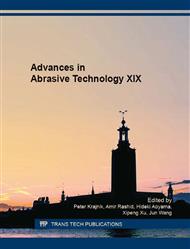p.28
p.34
p.40
p.46
p.52
p.59
p.64
p.70
p.79
Influence of Wheel Position Parameters on Flute Profile of Micro-Drill
Abstract:
Drill flute has a great influence on the drilling performance of micro-drill, and its profile largely depends on the grinding parameters, wheel profile and position. It is promising to obtain a desired flute profile with a standard wheel by adjusting the wheel position parameters. To investigate the influence of wheel position parameters on the flute profile, the micro-drill flute is simulated by MATLAB software considering the wheel installation angle and the offset distance from wheel origin to the drill blank origin, and the radial rake angle, flute width and chip evacuation capacity are quantitatively calculated to evaluate the flute profile. The simulated results show that the wheel installation angle has an obvious effect on the three performance parameters of flute profile, and the wheel offset distance only influences a parameter, i.e., the flute width evidently. The radial rake angle of drill flute increases obviously with the increased wheel installation angle, and decreases slightly with the increased wheel offset distance. With the decreased wheel installation angle, the flute width of drill flute increases causing the reduction of micro-drill strength but improvement of the chip evacuation capacity. With the increased wheel offset distance, the flute width also increases resulting in the reduction of micro-drill strength but no obvious change on chip evacuation capacity. Thus the wheel installation angle can be used as a main factor among the wheel position parameters to obtain the desired flute profile.
Info:
Periodical:
Pages:
52-58
Citation:
Online since:
October 2016
Authors:
Price:
Сopyright:
© 2016 Trans Tech Publications Ltd. All Rights Reserved
Share:
Citation:


